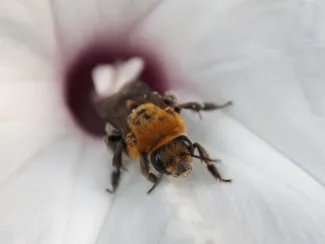Researchers with the Oklahoma Natural Heritage Inventory recently documented a rare species of bee, the morning glory longhorn, while conducting a survey at Cookson Wildlife Management Area. This is the first time the species has been documented in the state. Though generally thought to range east of the Great Plains, the bee was also documented in eastern Colorado in 2013.
“The bee is on the larger side, about the size of the first digit of your pinky finger,” said Mary Powley, research technician with the Oklahoma Natural Heritage Inventory. “The defining feature for the species is a distinctly shaped structure found just above the mandibles, but in general, this is a larger, more robust, and hairier bee species.”
Powley documented the bee in July while examining a patch of bigroot morning glory growing along a Cookson WMA roadside. The plant is known to host several specialist bees, or bees that provide their larvae with pollen from a strict set of plants. Her work was part of a larger effort by the Oklahoma Natural Heritage Inventory to document the state’s bee community.
As with many other states, Oklahoma does not yet have a published list of its pollinator or bee communities.
“We’re starting to get to the point where insect and pollinator conservation is deemed enough of a priority for there to be support for developing these types of lists,” said James Hung, biologist with the Oklahoma Natural Heritage Inventory and Powley’s supervisor.

The rare morning glory longhorn bee was first detected in Oklahoma in July 2022 by surveyors with the Oklahoma Natural Heritage Inventory. This female bee was photographed in Ohio.
Hung launched a statewide survey of native bees and the host plants on which they rely. He has also collaborated with other scientists to gather an initial list of native bees based on known published and unpublished records.
“Right now, that list is somewhere between 325 and 350 species. This initial list of Oklahoma bees has representatives from all six bee families that occur in the United States,” Hung said. "It’s hard to say how large the list could grow, but my colleagues and I are guessing that we could have somewhere around 750 species of native bees in the state.”
Hung’s baseline survey of Oklahoma bees is expected to continue until at least 2024. But he knows the work doesn’t have an expiration date.
“We could possibly be discovering new bee species in Oklahoma for decades to come.”
Hung and Powley are not alone in their endeavors. Besides the numerous land managers and botanists who supply them with vital intel, they are also helped by more than 1,000 naturalists who have contributed photographs of bees to the free community science platform iNaturalist. Help build Oklahoma’s list of native bees and other pollinators by uploading photographs and sighting details of the bees you encounter.
FOR MEDIA INQUIRIES, please contact ODWC Communication and Education Specialist Jena Donnell at jena.donnell@odwc.ok.gov or Oklahoma Natural Heritage Inventory Biologist James Hung at kljhung@ou.edu